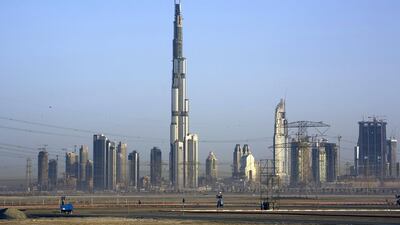My parents did a stint in the UAE in the 1970s. My dad worked in the construction industry, and while the term hardship posting is perhaps a little strong, he lived in makeshift camps in the middle of the desert, working a six-day week as he oversaw the building of roads, airports and other infrastructure. Every day, my mother would drive for miles (praying, in an age before mobile phones, that she wouldn't break down and be stranded in the baking heat) to take my brother to school.
My experience has been a little different. This year, like The National, I celebrate a decade of being in the UAE. I arrived in Dubai in 2008, at the height of the so-called boom. At the time, if you wanted to live in a place of your own anywhere north of the World Trade Centre roundabout, you could expect to pay at least Dh85,000 per year – the going rent for a studio in Discovery Gardens, although faulty drainage meant the community was regularly flooded.
Dubai was in the midst of a feeding frenzy; off-plan properties were selling like hotcakes; and new arrivals were harangued by banks trying to flog cards with unthinkably high credit limits. Colleagues at the Dubai publishing house where I worked were swept up in what felt like some kind of communal madness – taking on huge loans to buy cars and fit plush flats with designer furniture and 42-inch televisions. A friend that you made the week before might disappear a week later. All the while, the British press was giving the city a thorough beating. The media had taken it upon itself to cut this oil-rich upstart down to size. "Dubai is a financial Disneyland without the fun," wrote the late A A Gill, in a piece reflective of the tone of the time.
So much has changed. There's the obvious stuff. When I arrived, the Burj Khalifa was a work in progress, the Metro had yet to open and Kylie Minogue was still a big enough name to perform at the opening of Atlantis, The Palm. If you wanted a taxi, you'd wait an hour or two for the privilege. And skiing in the desert was still very much a novelty.
But it is far less obvious things that are a true marker of how much the city has evolved. Back then, residential communities felt like siloes, separate from each other and the rest of the city; now they feel like they are bedded in and part of a wider, connected whole. Arabian Ranches, The Springs and Jumeirah Village Triangle, all of which I have called home, are good examples.
When I moved to JVT five years ago, it was an isolated collection of cookie-cutter houses and non-signposted streets that had taxi drivers howling in frustration. There was very little landscaping or greenery, and there wasn't even a shop, let alone the schools, pharmacies, nail bars and pet,
plant and laundry shops that now line the streets.
A recent visit to Dubai’s newly opened La Mer really brought the point home. Ten years ago, JBR was the crowning glory of Dubai’s beachfront property prowess. For me, those bland, featureless towers, which so awkwardly impose themselves on the city’s skyline, are a symbol of a pre-VAT Dubai – while the subtle, site-specific La Mer, which sits so unassumingly on its stretch of beach, can be seen as a symbol of the city’s current, more mature manifestation. The fact that there are now places where you can take a gentle, casual stroll, without fear of being run over, is another positive trait of this “new” Dubai.
Dubai in 2018 offers a far broader living experience. You can go to the opera or a Bollywood-themed park. You can eat in fine-dining venues helmed by Michelin-starred chefs or understated, out-of-the-way eateries. You can watch a spot of polo, or volunteer at an animal shelter; you can binge on fast food,or buy organic produce fresh from local farms.
In 2018, Dubai feels like a far more self-assured place than it did in 2008. And one of the biggest changes is that, on its path to maturity, the city has managed to shed some of its transience. For many of us, it has become home – something that was all but unthinkable 10 years ago.
___________________
Read more from Selina:
Why social media influencers can be frustrating for journalists
Why a goodbye in the UAE can be particularly bittersweet
Four lessons learnt as a dog owner in Dubai
Writing Dubai off as one-dimensional only shows your own blinkered view
Why ageing in Dubai is a particularly painful process
___________________




